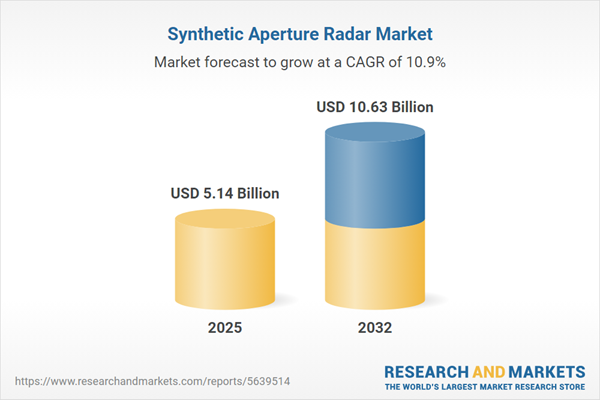Speak directly to the analyst to clarify any post sales queries you may have.
Senior decision-makers across regulated industries are turning to synthetic aperture radar (SAR) technology to strengthen operational resilience and ensure compliance in today’s evolving business landscape. As regulatory pressures increase and organizations seek dependable intelligence, SAR stands out for its ability to deliver actionable, high-resolution data that supports decisive leadership at speed.
Market Snapshot: Synthetic Aperture Radar Market Dynamics
The global synthetic aperture radar market is demonstrating consistent expansion, with revenues expected to grow from USD 4.64 billion in 2024 to USD 5.14 billion by 2025, reflecting a robust compounded annual growth rate of 10.91%. Organizations in defense, commercial, and public sectors are advancing adoption as regulatory demands intensify and sustainability goals enter sharper focus. SAR’s capability to generate high-resolution, real-time imagery allows decision-makers to maintain situational oversight, monitor complex infrastructure, and manage dynamic environmental risks. The reliability of immediate data is a key differentiator, particularly in sectors where oversight requirements and rapid response capabilities are under scrutiny.
Scope & Segmentation: Core Segments and Applications
This comprehensive analysis details the synthetic aperture radar ecosystem, breaking down technology segments, platforms, regional adoption, and industry participants. SAR deployment varies significantly across industries due to sector-specific requirements and shifting compliance drivers. The following core areas define the current market structure:
- Products: High-performance antennas, integrated sensor suites, advanced processors, analytics platforms, automated workflows, consulting services, and workforce training drive seamless integration and optimize the full value of collected data.
- Use Cases: Applications span agriculture optimization, disaster response, environmental compliance, defense operations, infrastructure monitoring, and oil and gas exploration for robust intelligence and compliance tracking.
- Deployment Platforms: Operational versatility is achieved via airborne vehicles, ground-based installations, maritime solutions, satellite constellations, and unmanned assets across varied environments.
- Frequency Bands: C, Ka, L, S, and X bands are leveraged to tailor system performance for distinct geographic and regulatory challenges.
- Geographies: Adoption rates differ across North America, Latin America, Europe, Middle East, Africa, and Asia-Pacific, reflecting regional infrastructure spending, regulatory requirements, and ongoing digitization efforts.
- Industry Stakeholders: Leading contributors such as Lockheed Martin, Raytheon Technologies, Northrop Grumman, Airbus SE, Thales, Leonardo, Saab, Mitsubishi Electric, Hensoldt AG, and Israel Aerospace Industries are fueling joint innovation and global advancement within the SAR space.
Synthetic Aperture Radar: Key Takeaways for Senior Decision-Makers
- Miniaturization and faster data processing are expanding SAR’s reach, enabling flexible deployments adapted to a range of operational conditions.
- Integrating edge artificial intelligence with cloud-based analytics enhances the speed and dependability of intelligence output, supporting more agile decision-making.
- Tighter collaboration between solution providers and end-users is shaping highly customized SAR solutions that improve infrastructure monitoring and compliance oversight.
- Adjusting procurement strategies and increasing local manufacturing contributes to greater supply chain resilience in the context of evolving regional policies and geopolitical shifts.
- Emerging applications, from precision agriculture to maritime surveillance and border management, are broadening SAR’s strategic role across industries.
- Industry partnerships are empowering organizations to respond swiftly to emerging operational needs and sustain competitive advantage over time.
Tariff Impact on SAR Supply Chains
The introduction of United States tariffs on imported SAR components is compelling companies to reevaluate sourcing strategies. Executive teams are proactively diversifying supply networks and considering regional manufacturing to bolster supply chain integrity in the face of shifting trade and regulatory environments.
Methodology & Data Sources
This market assessment draws from secondary research, academic literature, and direct consultations with SAR technology specialists. All data points are verified using official information from government, defense, satellite, and commercial sources, resulting in robust and actionable insights for industry leaders.
Why This Report Matters
- Enables executives to strengthen oversight and compliance strategies for heightened organizational resilience within layered regulatory frameworks.
- Provides targeted technology evaluation and supplier guidance, supporting well-informed procurement and investment decisions for both private and public sector entities.
- Delivers sector- and region-specific analysis to help leaders achieve sustainable business value and align with local operational priorities.
Conclusion
Synthetic aperture radar equips organizations with adaptive intelligence to navigate operational and regulatory transitions. This report offers actionable insights that support effective business and compliance strategies through focused SAR implementation.
Additional Product Information:
- Purchase of this report includes 1 year online access with quarterly updates.
- This report can be updated on request. Please contact our Customer Experience team using the Ask a Question widget on our website.
Table of Contents
3. Executive Summary
4. Market Overview
7. Cumulative Impact of Artificial Intelligence 2025
Companies Mentioned
The companies profiled in this Synthetic Aperture Radar market report include:- Lockheed Martin Corporation
- Raytheon Technologies Corporation
- Northrop Grumman Corporation
- Airbus SE
- Thales S.A.
- Leonardo S.p.A.
- Saab AB
- Mitsubishi Electric Corporation
- Hensoldt AG
- Israel Aerospace Industries Ltd.
Table Information
| Report Attribute | Details |
|---|---|
| No. of Pages | 184 |
| Published | October 2025 |
| Forecast Period | 2025 - 2032 |
| Estimated Market Value ( USD | $ 5.14 Billion |
| Forecasted Market Value ( USD | $ 10.63 Billion |
| Compound Annual Growth Rate | 10.9% |
| Regions Covered | Global |
| No. of Companies Mentioned | 11 |









